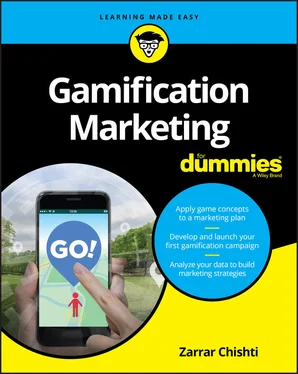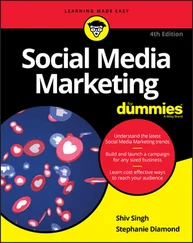 Keeping the gameplay simple will create a fun, interactive, and easy-to-play campaign. It’s always better for games to be simple and quick, so your audience will pick up the campaign and play right away without paying too much attention to the rules.
Keeping the gameplay simple will create a fun, interactive, and easy-to-play campaign. It’s always better for games to be simple and quick, so your audience will pick up the campaign and play right away without paying too much attention to the rules.
Creating too many rewards
Throughout this book, I go on a lot about rewards. After all, rewards are the ultimate goal for gamification marketing campaigns. But you can have too much of a good thing. If your audience is being rewarded for every little action, the rewards won’t mean anything. Your entire reward system, along with your entire gamification campaign, will be rendered null and void.
 Try to limit the ways your audience is awarded points, badges, and rewards. By doing this, your audience will take them more seriously, and the rewards themselves will feel special.
Try to limit the ways your audience is awarded points, badges, and rewards. By doing this, your audience will take them more seriously, and the rewards themselves will feel special.
 Also, keep both the objectives and the rewards simple. Choose two or three actions that you want your users to carry out. By rewarding users for carrying out these specific behaviors, you can motivate them to do exactly what you want.
Also, keep both the objectives and the rewards simple. Choose two or three actions that you want your users to carry out. By rewarding users for carrying out these specific behaviors, you can motivate them to do exactly what you want.
Game mechanics are the vehicles that drive your marketing goals and objectives. Use too many, and your message becomes over-saturated and your audience will start to become confused over the goals being communicated to them. Use too few, and the message won’t be clearly communicated.
As an example, you can use badges to communicate achievements to your audience. Badges keep them motivated to reach the next level or earn another badge. Badges, which mark special achievements, give your audience a way to feel connected to your campaign.
However, a common mistake I see is when my clients force their audience to earn their next badge by making them do something they don’t want to do. For instance, maybe the only way to progress is by sharing their progress on their social media platforms. Not everyone will want to do this, and some people will bail.
 In this example, the game mechanics of badges should be looked at as a way to recognize an achievement, not the reason for your audience to do something.
In this example, the game mechanics of badges should be looked at as a way to recognize an achievement, not the reason for your audience to do something.
Gamification marketing may be more likely to go viral than ordinary marketing campaigns. However, you can’t bank on this happening. It will either happen or it won’t. I never create a gamification campaign for virality.
The sheer volume of campaigns that contain online videos, photos, cartoons, memes, infographics, posts, and other easily sharable content is so enormous that it unlikely for any campaign to go viral.
Most companies I work with have to acknowledge that the primary goal of their gamification marketing campaigns is to create a buzz within their industry.
 You can’t control the outcome, but you can control the development, design, and launch. Work on this, and the buzz within your industry will be guaranteed.
You can’t control the outcome, but you can control the development, design, and launch. Work on this, and the buzz within your industry will be guaranteed.
Creating a campaign that can’t be played at work
 No one will want to play your campaign if game elements (for instance, sudden loud sound effects, annoying track music, or full-screen animation) can cause sudden embarrassment at work. These elements may be the norm in online games, but use them with caution in your campaign.
No one will want to play your campaign if game elements (for instance, sudden loud sound effects, annoying track music, or full-screen animation) can cause sudden embarrassment at work. These elements may be the norm in online games, but use them with caution in your campaign.
When designing a gamification campaign, I like to imagine that the audience is sitting one desk away from their manager. If you think of it this way, the elements you develop will be subtle and stress-free so that everyone can enjoy and engage with your campaign, wherever they are.
Assuming your audience will understand games
Unless your company is in the gaming and entertainment industry, your audience may not be familiar with gamification campaigns. I see this as a major plus.
All marketing campaigns are looking for some way to create a disruption within their industries. Gamification helps to get your audience’s attention and promote your message. If you suddenly launch a game to an audience who isn’t usually presented with this type of marketing, you’ll pique their interest.
The mistake I see is assuming your audience will understand the point of the gamification elements. They won’t. To overcome this hurdle, introduce as many help elements as you can. These may include videos, FAQs, in-game instructional messages, and a chat window.
If you accomplish this goal, once-unknowledgeable audiences will see your company as the pioneer and voice of authority in gamification marketing. For me, this is the best possible result for your team’s hard work.
Part 2
Beginning Your Gamification Marketing Quest
IN THIS PART …
Define your audience and deliver a uniquely engaging campaign to them.
Explore the various types of gamification engagement tools available for your campaign.
Assemble a dream team to help you design, build, and maintain your gamification model.
Understand the technology that will power your gamification marketing campaign.
Chapter 3
Identifying Your Target Audience
IN THIS CHAPTER
 Defining your perfect audience
Defining your perfect audience
 Delivering an engaging and personalized campaign
Delivering an engaging and personalized campaign
 Tapping into your existing data
Tapping into your existing data
 Mining your social media channels
Mining your social media channels
Ideally, your gamification marketing campaign will deliver a personalized experience to as wide an audience possible. To accomplish this goal, you can’t afford to take a global and generalized approach to your marketing efforts.
You need to gather key data on precisely who your target audience will be. After you find this data, you can target your campaign directly to them. However, to obtain the best results, you’ll need to exhaust all data channels you have on your existing customers and social media followers. These are people who already know about you and have engaged with your company.
After you’ve mined this data, your campaign will be sending messages that are customer-centric and content that targets your audience. Identifying your target audience will make your gamification marketing campaign far more efficient and successful.
 In almost all ad campaign managers, you can drill down on exactly whom you want to see your ads. So, identifying and perfecting your target audience to advertise and promote your campaign, will greatly reduce wasted expenditure on ads.
In almost all ad campaign managers, you can drill down on exactly whom you want to see your ads. So, identifying and perfecting your target audience to advertise and promote your campaign, will greatly reduce wasted expenditure on ads.
Читать дальше

 Keeping the gameplay simple will create a fun, interactive, and easy-to-play campaign. It’s always better for games to be simple and quick, so your audience will pick up the campaign and play right away without paying too much attention to the rules.
Keeping the gameplay simple will create a fun, interactive, and easy-to-play campaign. It’s always better for games to be simple and quick, so your audience will pick up the campaign and play right away without paying too much attention to the rules. Also, keep both the objectives and the rewards simple. Choose two or three actions that you want your users to carry out. By rewarding users for carrying out these specific behaviors, you can motivate them to do exactly what you want.
Also, keep both the objectives and the rewards simple. Choose two or three actions that you want your users to carry out. By rewarding users for carrying out these specific behaviors, you can motivate them to do exactly what you want. No one will want to play your campaign if game elements (for instance, sudden loud sound effects, annoying track music, or full-screen animation) can cause sudden embarrassment at work. These elements may be the norm in online games, but use them with caution in your campaign.
No one will want to play your campaign if game elements (for instance, sudden loud sound effects, annoying track music, or full-screen animation) can cause sudden embarrassment at work. These elements may be the norm in online games, but use them with caution in your campaign. Defining your perfect audience
Defining your perfect audience










